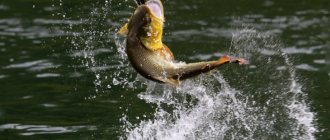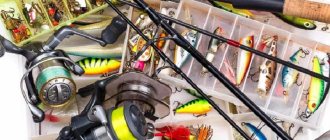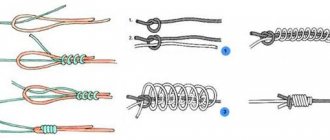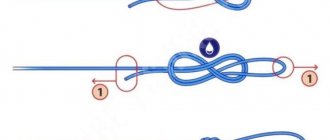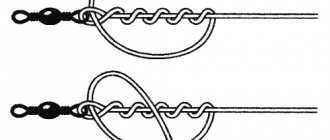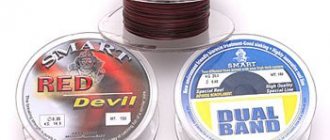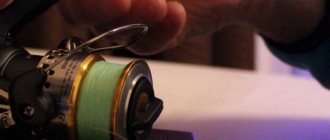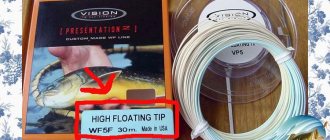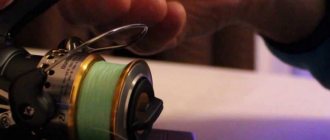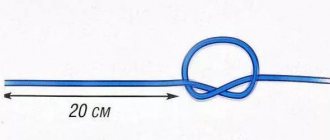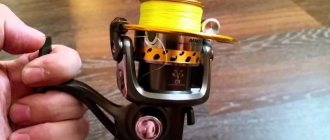Rules
When tying knots from braided fishing line, it is worth considering the following individualities:
- Wetting. This is an indispensable requirement in the process of executing nodes. When dry, the fishing line heats up. Naturally, this is a short-term process, but it affects the structure of the fishing line - it is destroyed.
- Section. As the knot is tightened, the line twists, which reduces its strength. Lines with rounded shapes have less curling than flat braided ones.
- Treatment. To increase the strength of the nodes, it is recommended to apply glue to the places of the nodes and fastenings. The longest holding time should be more than a day.
- Tying. When tying knots, it is necessary to leave free ends of the fishing line more than 4 cm long. Then, after verifying their strength, the ends can be removed, taking into account the remainder of 4 mm.
Before looking at the main components, introducing some concepts:
- running end - part of the fishing line that makes movements;
- root end - part of the fishing line not used for tying;
Factors affecting strength
The strength of the connection is influenced by the following factors:
- Number of twists. It would seem that the more turns of fishing line you make, the stronger the knot will be. But in practice this is not always the case. And all because the woven thread tends to “burn” when tightened. This is due to the fact that during screeding, individual fibers rub against each other and generate a lot of heat, which “burns” up to 20-25 cm of the cord, reducing its strength. To keep the tackle strong, make an average number of twists. Then the connection point will be quite reliable, and the fishing line will remain quite strong.
- Section shape. This only applies to intertwined cords, as they come in round and flat types. When tightening the knot, the round thread is subject to less deformation, and therefore the joint with it will be of better quality.
- Thickness of fishing line. The thinner the thread, the more it deforms when the knot is pulled together. And any deformation reduces strength. Therefore, the thicker the thread, the stronger the connection.
The strength of the fastening can also be affected by the thickness of the tied threads. The strongest knot will be the one tied from fishing lines of approximately the same diameter. But in practice, the braided thread is often thinner compared to monofilament. In this case, only some of the knots can guarantee strength and only on the condition that the thickness of the woven cord does not differ by more than 30-33%.
Expert opinion
Knipovich Nikolai Mikhailovich
Zoologist, hydrobiologist. I am interested in fishing at a professional level.
Important! Be sure to wet the knot with water before tightening it. Wet threads glide and stretch better, and therefore you can make the connection stronger. If you tighten the knot in a dry way, then the prey will tighten it “wet”, which is more likely to unravel it and take part of the gear with it.
In the case of connecting monofilament and braid, wetting has another advantage. After all, water is an excellent heat absorber. Therefore, when tightening the knot, the braid will deform less, and therefore the tackle will retain a greater margin of safety.
The best knots for attaching braid to braid
Triple knot method
Annotation:
- First you need to fold 2 braids, taking into account the smoothing of the ends. Next, counting a segment of more than 20 cm from both ends, you need to clamp the fishing lines.
- Then, holding both lines together, you need to form a loop.
- Then you should triple thread the ends of the braids into the formed loop.
- Next you should tighten both ends of the folded braids.
- Finally, to fully form a strong knot, you need to pull each basket separately.
A high-quality assembly should not retain empty holes between parts of the whorl. This unit is characterized by the greatest strength.
Method "Centaurus"
Annotation:
- To begin with, the fishing lines must be arranged in a parallel manner.
- The running end of the fishing line is wound around the second fishing line more than 5 times. In the initial turn it is necessary to leave an open part in the form of a small loop.
- The tip of the running part of the braid is passed through the resulting loop in the initial turn and is tightly stretched.
- Such acts are exactly performed with other fishing line.
- At the end, the ends of both lines should be stretched to the sides - the turns will move towards each other, forming a stop

The advantage of this method is its versatility and compactness. Also, strong fastening provides durability and reliability, taking into account the preservation of load capacity by more than eighty-five percent.
Method "Blood Ties"
Annotation:
- The fishing lines must be folded one on top of the other (crosswise) , leaving an end of more than 20 cm for each braid.
- The intersection of the lines must be held with your finger and more than 8 turns of one line made around the second one.
- After which the running end of the winding braid is turned back and passed through the crossed part of the lines. In this case, the through part of the lines must be clamped with a finger, with a loop at the base of the intersecting part.
- The running end of the 2nd line must be performed in the same manner , returned back and inserted into the free part of the line pressed with a finger. Then you need to pull each knot in turn, of course, wetting the knots.
- Finally, it is necessary to trim off the excess parts of the running ends of the fishing lines.
READ Fishing mugs for pike: design, equipment, methods of fishing on lakes and rivers
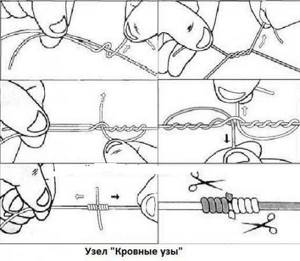
The corresponding difference and advantage of the knot is its strength and practicality.
Photo tips on how to tie fishing line to a reel
Note!
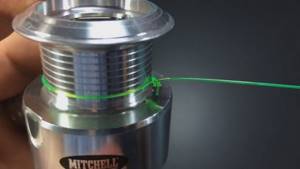
How to tie a fishing line to a reel - methods, tips on how to tie correctly and an overview of the most reliable knots (85 photos and videos)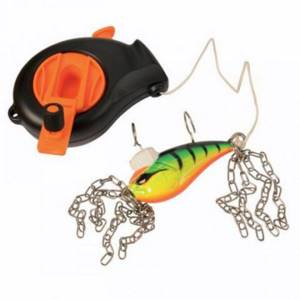
Cuts for wobblers and spinners - how to make a simple homemade cut. 110 photos and videos of practical tips
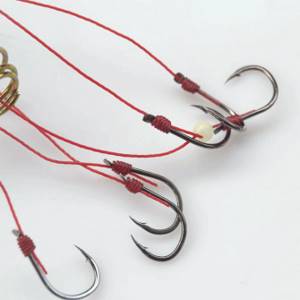
How to tie a hook to a fishing line - advice from professionals and the best patterns for beginners (115 photos and videos)
Read here Fishing ring: making and installing gear with your own hands. Ring fishing from the shore and boat (110 photos)
Help the project, share on social networks 

0
How to tie a braid to a leash?
Loop in loop method
Annotation:
- First, you need to take a braided line in the form of the main fishing line, leave a segment of more than 40 cm, fold them in half, forming a single loop.
- With the running ends of the fishing line, it is necessary to make more than 3 passes, which wrap around the action in a loop, ultimately resulting in a knot appearing.
- The knot is tightened by holding the loop and the free ends of the fishing line. During tightening, the knot should be wetted; (the same actions must be performed with the lead line).
- Next, the loop of the braid must be threaded into the loop of the leash, and the root tip of the leash must be threaded into the loop of the braid. Based on the results of the actions, the root ends of the fishing lines should be pulled together.
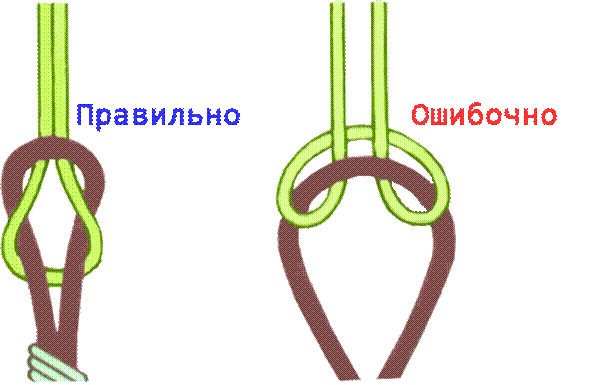
Loop in loop: 2 options
If done correctly, the loops form an "8" shape.
The advantage of this method is its greater strength, as well as practicality and ease of implementation. It is equally easy to use in tying leashes of any type. Also, the process of dismantling and replacing with other leashes is painfully simple.
Clinch method
Annotation:
- Take a leash line with a length of more than 30 cm. The leash must be folded in a double layer, placed against the braided line and pressed down with your finger.
- It is necessary to throw the running end of the leash over the braided line and the auxiliary end, thereby forming the shape of a loop. At the same time, the braid must be inside the loop.
- After which you need to make more than 6 turns along the braid and one part of the leash. In this case, the loop must be adhered to with your finger.
- At the end of the action , it is necessary to move the running part of the fishing line to the loop, tighten the ends of the fishing lines;
- The remaining ends of the running lines must be trimmed, leaving more than 2 cm.
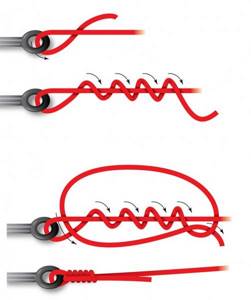
The advantage of this method of attachment is that it can be used when fishing in difficult conditions: rocky bottom, snags and aquatic plants.
How to knit two braids?
Situations often arise when you need to knit braid to braid. For example, merging the backing with the main core. Since many cords have a smooth structure, to connect them you need to use self-tightening options that will not unravel under load. There are different ways to tie the braid together, but the best is considered to be the Bloody Knot, performed as follows:
- The two free ends of the multifilament fishing line are brought towards each other;
- We wrap the second around one. We make about 5–7 turns;
- Now in the opposite direction we wrap the second braid around the first. Also 5–7 revolutions;
- We return the free ends back to the beginning of the knot and thread them into the resulting loops;
- All that remains is to smoothly tighten the threads, cutting off the excess ends.
If we are splicing a thin and thick multi-filament thread, then it is advisable to fold the small-diameter fishing line in half. This option is suitable if you need to tie a monofilament line to a fishing line. Other fishing knots for line are either more complex or have less strength.
Attaching the hook and swivel to the fence
With hooks:
Uni method
- The fishing line with the running end must be inserted into the eye of the hook, taking into account the formation of a loop. The running part of the braid is located on the upper side of the fishing line and is threaded into the loop.
- Next, you need to wrap the layers of the basket around the chassis, making over 8 turns.
- After which you need to tighten the knot.
Uni node
The knot is considered more ordinary, but at the same time very reliable.
READ CASTING - from hatred to complete delight!
Clinch Knot Method
Annotation:
- The running end should form an open loop, the length of which should be 12 cm.
- The highest part of the loop is threaded through the ring of the hook and stretched in this way, ultimately resulting in the end of the undercarriage being more than 6 cm.
- After which the root end and the loop should be framed with the 6th reverse layer of the running end.
- Next, after completing the windings of the fishing lines, the chassis must be passed through the loop of the fishing line.
- The knot should be moistened and tightened tightly, and the excess parts of the fishing line should be cut off, leaving a length of more than 3 mm.
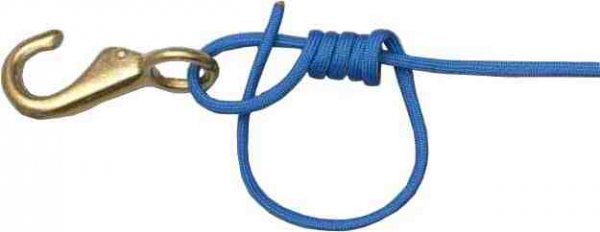
This method is the most common and quite convenient. Using it you can tie not only hooks, but also baits, swivels and a number of pieces of equipment.
With swivels:
"GRINNER" method
- First, the braid must be passed twice over the eye of the swivel for greater strength.
- The running end of the fishing line should be placed on top of the fishing line in a cross position , forming a loop shape. It is necessary to grab the braid, taking into account the 10 cm height above the swivel for tying the knot.
- After that, you need to pass the running gear of the braid along the loop and make 6 turns around the braid. In this case, it is necessary to take into account that having completed the last turn, the running end of the fishing line must be pulled to the outer side of the loop, thus forming the shape of a knot.
- Having moistened the knot, it is necessary to tighten the knot evenly so that the position of the turns is tight.
- Finally, the main part of the fishing line must be pulled so that the knot should eventually slide towards the eye of the swivel.
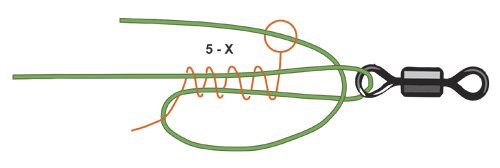
This type of knot is considered one of the most reliable, used in the case of tying parts with rings. A corresponding feature of the unit is a good level of load-carrying capacity, which is ninety percent.
Method "Palomar"
- First, the running end of the fishing line is inserted into the eyelet , stretched over 5-8 cm, and the fishing line is passed back over the eyelet, leaving behind a part of the fishing line that is not completely pulled into the eyelet, in the form of a loop.
- The loop is held with your fingers.
- Next a knot is made. In this case, it is necessary to pay attention to the presence of the ear in the central part of the knot.
- After which the windbag with the gun is threaded into the loop and pulled in the opposite direction. In this case, it is necessary to wet the knot.
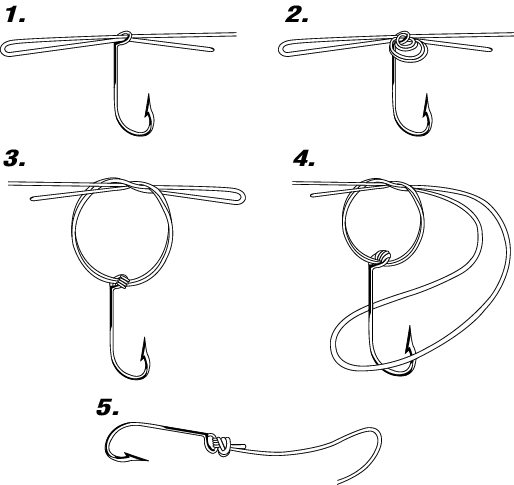
The same method can be applied to the hook.
"Palomar" is a more common and convenient method. In terms of its execution, it is quite ordinary, but provides the highest strength and reliability.
The most reliable knots for braiding
Research has shown that each type of cord requires a specific (its own) version of the knot. From the total number of nodes, several main ones can be distinguished:
Palomar knot
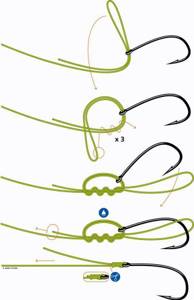
The Palomar knot is one of the simplest and, at the same time, the most effective knitting methods. To attach one of the fishing accessories to the fishing line, you need to make a few simple movements.
- The piece of fishing line must be folded in half.
- The fishing line, bent in half, needs to be threaded into the eye of the hook.
- After this, you should tie a regular knot without tightening it. The eye of the hook should be in the center of the loop.
- A hook is pulled into the resulting loop.
- At the site of the knot, the braid should be moistened and the knot should be carefully tightened. Excess line is trimmed using scissors.
The length of a piece of fishing line depends on the length of the leash, and can be in the range of 20-50cm.
Uni (Uni knot, Grinner knot)
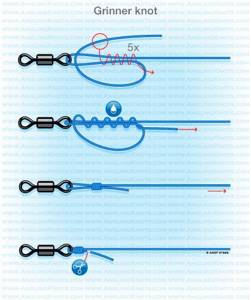
This knot is used in cases where it is impossible to stretch a double line into the eye of the hook: the eye is either very small, or a very thick line. Power Pro recommends using this type of knot for tying their products. It is more complex, and to learn how to knit it, you will have to practice:
- Tying a knot begins by pulling braided line through the eye of the hook, after which a loop is made.
- Then the end of the fishing line is wrapped several times around the main fishing line and after that a second loop is made.
- The end of the fishing line is passed through the second loop (the first), and 5-7 turns should be made around the double fishing line.
- After this, the line is wetted and the knot is tightened. If there is excess fishing line, cut it off using scissors.
It is recommended to master the technique of knitting a Uni knot by using, to begin with, long pieces of fishing line, about 60cm.
Clinch (Improved Clineh)

This type of knot can be recommended for knitting braided fishing line. It is quite simple and can be mastered by any beginning angler.
- A piece of braided fishing line, about 10-15cm long, is pulled into the eye of the hook.
- After this, the end of the fishing line is wrapped around the main fishing line (along with the hook shank), and 5-6 turns can be made.
- The free end of the fishing line is pulled through the small and large loops formed as a result of such manipulations.
- At the final stage, the loop is wetted and the knot is tightened with maximum effort. The excess ends of the fishing line are removed.
When tying a knot, the hook should be kept in the eye area so that all the loops formed can be saved.
Bloody knot
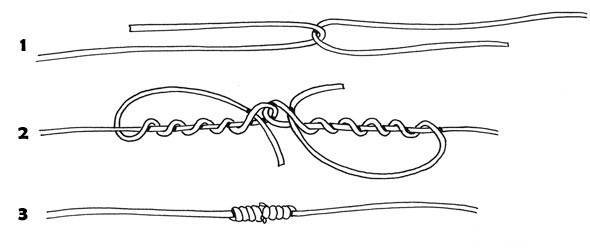
This type of knot is used to securely connect two pieces of cord. Moreover, you can connect sections of different thicknesses, but the difference in diameter should not be more than twice. With its help, you can tie a leash made of monofilament fishing line to the braided line.
- Two pieces of fishing line are located next to each other in opposite directions.
- Then take one end and wrap it around the other line 5-6 times.
- This end of the line is wrapped back and pushed between the turns in the opposite direction.
- The second end of the fishing line is taken and the same procedure is performed with it as with the first end. As a result of this, in the center of the two turns (there should be turns of fishing line on the left and right) two ends of the fishing line should peek out, directed in different directions.
- The entire knot, with all the turns, is wetted and by moving the two hands in opposite directions, this knot is tightened. Excess line is removed.
The number of turns depends on the thickness of the fishing line. For a braided fishing line, 2-3 turns will be sufficient, for a regular fishing line with a diameter of 0.3 mm or more - 4 turns, for a regular fishing line less than 0.3 mm, 5 turns are enough, for a fishing line with a diameter of less than 0.15 mm, this number of turns can equal 6.
Source: FishingDay.org
Attaching the braid to the reel spool
When connecting braided fishing line to reel spools, it is necessary to take into account the peculiarity of the braid, and specifically the presence of slipping, as a result of which the cord may jump out.
Therefore, the use of adhesive tapes is recommended.
A simple type of fastening is the following option:
- The line must wrap around the spool.
- The running part of the fishing line is bent around its solid part.
- The section of fishing line going to the bending point of the spool is superimposed with the 7th reverse layer of the fishing line limb.
- It is necessary to take into account that most of the braid is inside the loop.
- Next, the root part of the fishing line must be threaded through a loop , taking into account the coverage of most of the fishing line and tightened tightly.
READ Spinning or baitcasting. Conditions of use.
Arbor knot method
- First, you need to wrap the line around the reel. A section is left for tying a knot.
- After which, by means of wrapping the line going to the reel , it is necessary to form a knot at the running end of the braid. This ensures that the nodal part of the line slides towards the reel.
- An additional knot is made on the free part of the braid , which will act as a stopper. Using it, the first node will be securely attached.
- When tightening the knots using wetting , the remains of the running and main ends must be cut off in order to prevent tangling during winding.
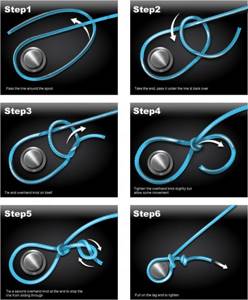
This method provides powerful fastening and self-tightening function.
The strongest knots for tying “braid” with fluorocarbon
Method of tying a knot “Mahin leader knot”
The first knot we will look at is called the “Mahin leader knot”, or simply “carrot”. Let's consider the method of knitting it:
- We take the end of the fluorocarbon fishing line and tie an ordinary (edge) knot without tightening it.
- We insert the end of the “braid” twenty centimeters long into the resulting knot.
- With the inserted tip of the “braid” we wrap the fluorocarbon, making ten turns.
- The tip of the “braid” remaining after the completed revolutions is wrapped back around the resulting turns six times.
- After returning the wraps to the loose knot, insert the tip of the braid into the loose fluorocarbon knot.
- Wet the knot and tighten it by pulling the braid and fluorocarbon in different directions.
- We cut off the ends, leaving about one centimeter.
Method of tying a knot “Double uni knot”
The second knot we are looking at is called the Double Uni Knot and is most often used to tie a fluorocarbon leader to the main line - the braid. Let's consider the method of knitting it:
- We take the ends of the fishing lines and fold them with their tips towards each other.
- At the end of the “braid” we make a loop, in the opposite direction from the folded tip.
- We wrap the remaining tip between two fishing lines inside the loop for three or four turns.
- Pull the end, tightening the knot.
- We repeat a similar procedure with the other fluorocarbon tip.
- We tighten the resulting knots into a single knot, pulling the fluorocarbon and the “braid” in different directions.
- Trim off the excess ends.
How to properly tie a “Carrot” knot for a shock leader - practical instructions for use.
For a step-by-step fishing guide - fly fishing for beginners, see below.
Tying patterns and a detailed story about the conditions and fishing techniques using lead rigs are in the next article.
Attaching the bait to the braid
“Compacted loop” method
- A loose, loose knot is formed , with a segment less than 15 cm from the ends of the braid, the running end of which is threaded into the bait ring.
- A free end is left with a segment of up to 10 cm , which will be drawn in the center of the braided knot;
- A tight knot is pulled behind the main line. It should be pulled behind the working end, as a result of which a loop is formed.
- Next, by means of wrapping the working part of the braided main line , it is necessary to form an additional knot.
- The additional knot must be tightened with the main braid to the primary knot. It is necessary to trim the remains of the braid, leaving a 4 mm piece.
It is considered the most suitable method of attaching virtually all types of baits.
"RAPALA" method
- A knot is formed with an open part in the shape of a loop , located in a section of up to 20 cm from the ends of the braided fishing line, and one of the running ends of the fishing line must be passed along the bait ring.
- Leaving the running part of the fishing line with a length of more than 15 cm , it is necessary to pass it along the central part of the knot.
- It is necessary to wind the running end around most of the braid with 6-7 turns , pull the loop closer to the bait ring, pulling with the running end. The length of the remaining part must be more than 2 cm.
- After which the running part of the fishing line is turned back and passed through the central part of the knot a second time.
- The final step is to alternately and carefully tighten the main and working lines.
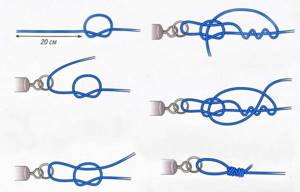
The remaining excess part of the fishing line is cut off, separating a 3 cm piece.
The value of the knot is to ensure the correct positioning of the bait and its free play. By its own personality it is non-slip. Easy to do. It is reliable with a strength level of over 95%.
Blitz tips
- A perfectly tied knot should be even , without any places with slack or gaps.
- In the case of attaching a hook or swivel to a braided line , it is necessary to find their effect on the structure of the fishing line. It is worth keeping in mind that they can cause a shift in the layers of fishing line threads, which reduces its strength.
- Taking into account the individuality of the basket, when tying a knot, for example, using the Clinch method , to prevent slipping and untying, the tip of the braid must be melted over low heat.
- When attaching the braid to the reel, the line must be tensioned. In another option, in the process
Source
YouTube

